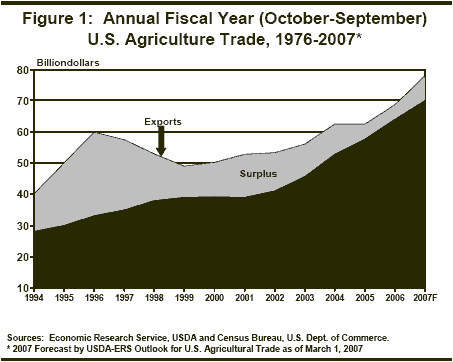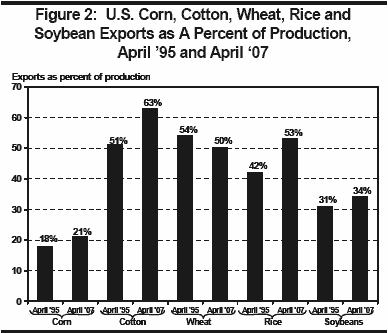AG-ECO NEWS
Vol. 23, Issue 12, April 18, 2007
Jose G. Peña
Extension Economist-Management
Record Ag Trade Forecast For 2007; NAFTA Almost Fully Implemented
Increased Export Dependence Will Keep U.S. Markets Volatile
USDA-ERS, March 1, 2007, Outlook for U.S. Agricultural Trade report, forecast U.S. agricultural exports for 2007 at a record $78.0 billion, up $1 billion from the preliminary estimate in November ‘06 and $9.3 billion higher than 2006. This is the second highest increase in exports on record. The Ag trade surplus forecast of $8.0 billion is up 68.2 percent from a 2005-06 average of $4.75 billion. (See Figure 1). Meanwhile, Ag trade between the U.S., Mexico and Canada has increased about 358 percent since the early ‘90’s as the North American Free Trade Agreement (NAFTA) is almost fully implemented and the last of the transitional trade restrictions will be removed effective January 1, 2008. 
Exports Increasing
According to the Ag Trade Outlook report, two-thirds of $9.3 billion increase in exports is due to increased grains and oilseeds exports. Increased demand for biofuels, reduced competition for wheat, and only moderate growth in South American oilseed production is keeping U.S. grain and oilseed shipments higher than otherwise would be the case.
It is significant to note that while the estimated soybean export value remained unchanged (from the November ‘06 estimate) as higher unit values offset lower export volumes, the estimate of corn exports was raised to a record $9.2 billion on further upward revisions in volume, i.e., corn export volume increased even with near record prices, indicating strong foreign demand. Livestock product exports are up mostly due to higher meat volumes, while processed products are driving nearly all of the increase in horticultural exports.
Imports Up
Agricultural imports were also forecast at a record $70 billion, up $1 billion from the November ‘06 forecast and up $6 billion from $64 billion in Ag imports during 2006. Although at a record high level, the rate of growth in imports from 2006 to 2007 is the slowest since 2003, partly the result of a weaker dollar. Horticultural products account for half of the growth, the rest is from vegetable oils, grains, and sugar and tropical products.
Export Dependence Increases Market Risk, but Indicates Stronger Demand
U.S. agriculture production is growing faster than domestic consumption. Production above domestic consumption is export bound, indicating that U.S. is becoming even more export dependent, especially for key crops such as cotton, rice and soybeans. (See Figure 2). For example, U.S. cotton exports during the 2005/06 season at 18.04 million bales was up 25 percent from 14.44 million bales exported during the 2004/05 season. The initial new cotton crop production estimate for the 2007/08 season, based on March 1, 2007 planting intentions, at about 18.88 million bales is down 13.1 percent from 21.73 million bales produced this past season. With an export estimate of 15.5 million bales, if these forecasts are realized, exports will account for about 82 percent of the new cotton crop production estimate. 
Increased export dependence appears to indicate that U.S. commodity prices will remain fairly volatile and continue to carry high risk of change. Export dependency makes prices subject to production, political and many other changes at home and abroad.
Opening and stabilizing export markets is very important to the U.S. The U.S. relies heavily on export markets to sustain prices, Ag revenue and help balance the U.S. budget. U.S. export revenues accounted for 20-30 percent of U.S. farm income during the last 30 years and are projected to increase slightly.
WTO and NAFTA
Increased international trade dependence means that we should have workable, mutually agreeable trade treaties in place to facilitate trade. The current Doha Round of trade negotiations at the World Trade Organization (WTO) in Geneva was suspended on July 24, 2006 after 5 years of negotiations. While the negotiators are trying to revive the negotiations, there doesn’t appear to be sufficient political pressure from the U.S. and other key players to come to an agreement.
WTO negotiations failed because the parties were very far apart in negotiating the reduction and or elimination of trade barriers and/or import tariffs and reductions in farm payments to U.S. producers. As Farm Bill 2007 is developed, there is very little doubt that the budget deficit, export trade dependence and challenges to U.S. farm policy (WTO dispute settlement) may influence changes to the market risk protection currently provided by the 2002 Farm Bill.
Meanwhile, implementation of the North American Free Trade Agreement (NAFTA) is drawing to a close. In 2008, the last of NAFTA’s transitional restrictions governing U.S.-Mexico and Canada-Mexico agricultural trade will be removed, ending a 14-year transition period to eliminate numerous barriers to regional agricultural trade. After initial production/agribusiness adjustments were made to accommodate more liberalized trade among the three trading partners, it appears that the agreement is working smoothly, except for some key areas such as live cattle, corn and sugar. Ag trade between the U.S., Mexico and Canada has increased about 358 percent since the early ‘90’s. US agricultural exports to Mexico have tripled to about $11 billion since NAFTA was implemented in 1994, while exports to Canada have more than doubled, reaching $11.9 billion in 2006.
